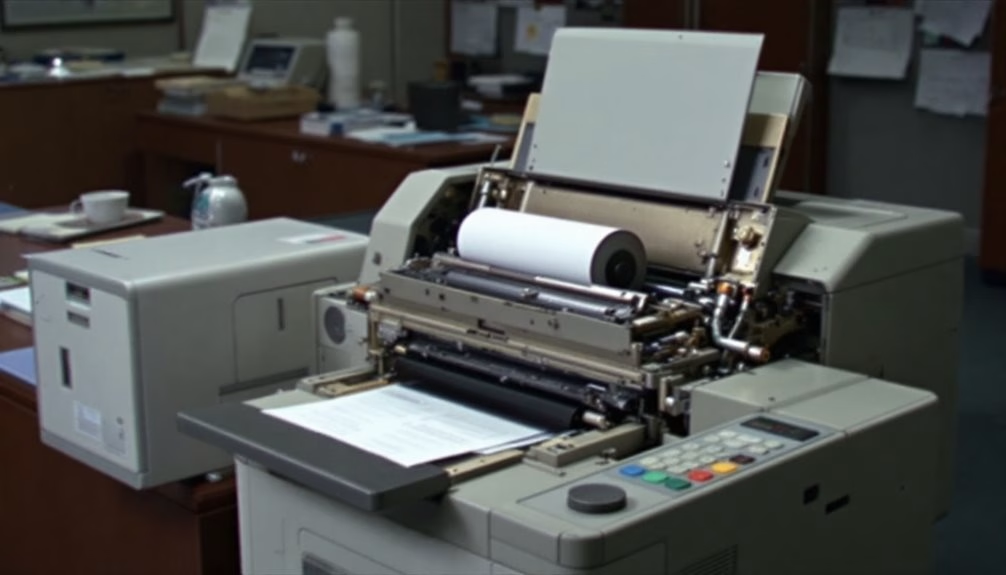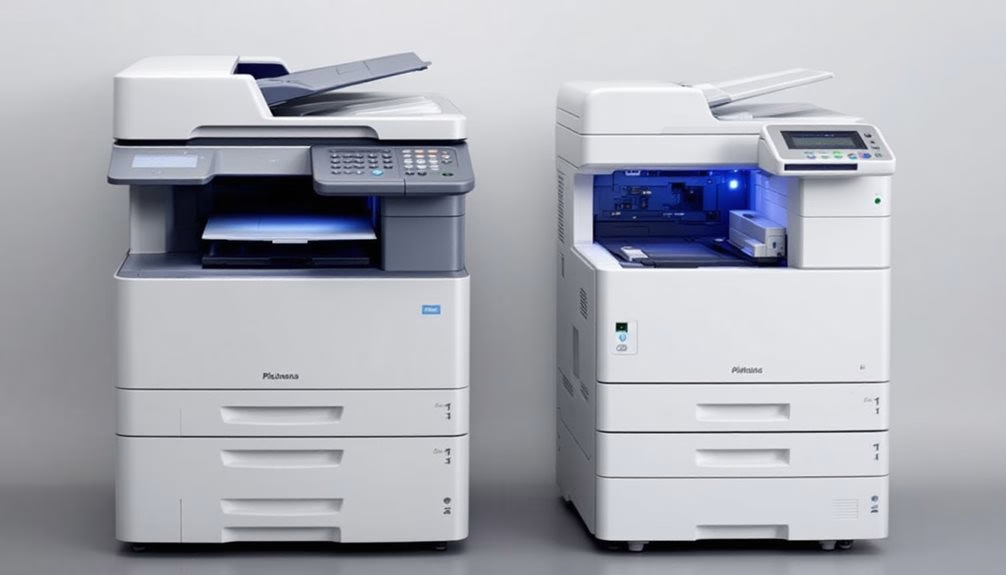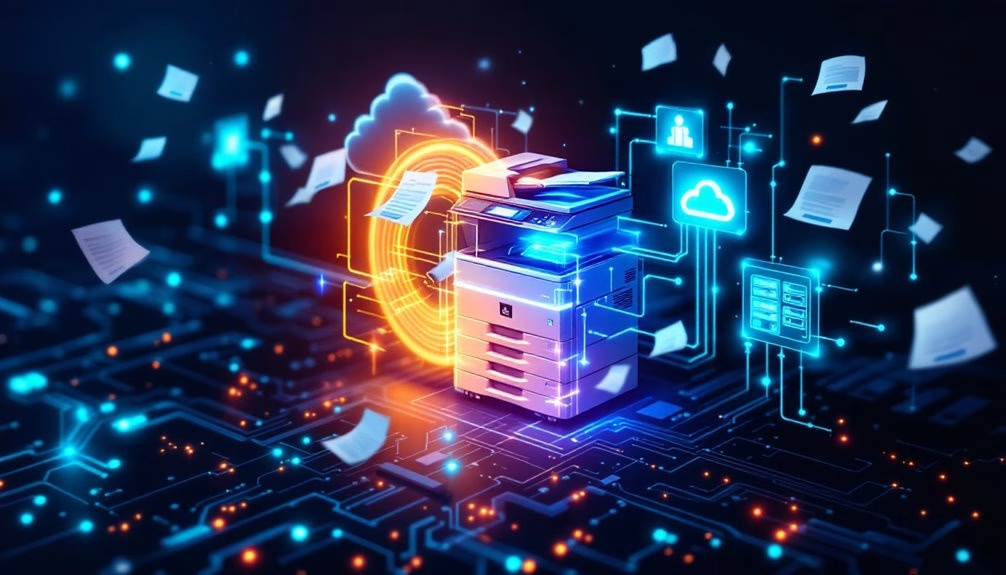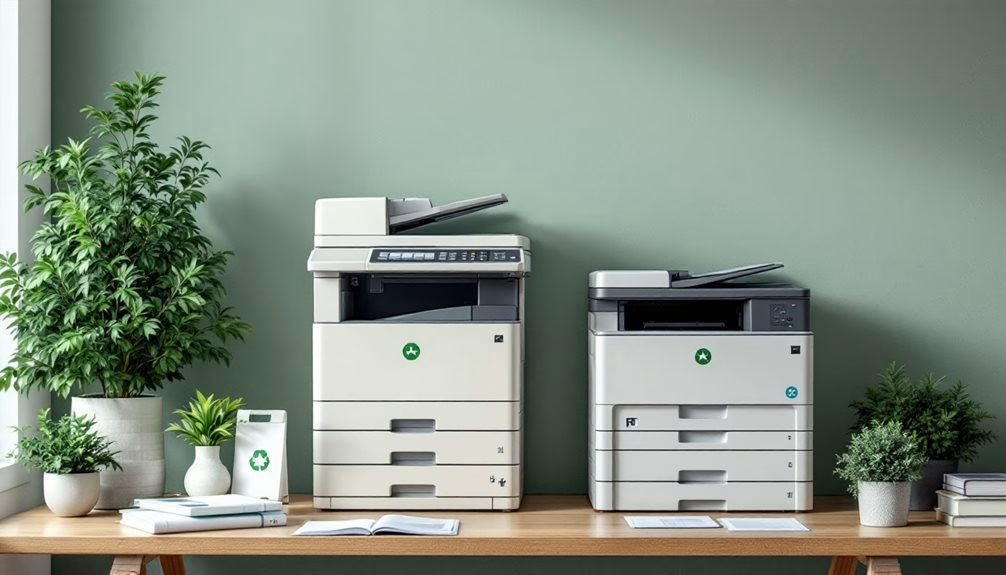Let’s explore how copying technologies have transformed from basic manual methods to today’s sophisticated digital systems. We’ve come a long way from the messy carbon paper days to our current cloud-connected devices. The journey through this evolution reveals intriguing innovations, unexpected breakthroughs, and revolutionary changes that shaped modern office productivity. What might surprise you is how a frustrated patent clerk’s invention in 1938 set everything in motion.
Expert Highlights
- Early document duplication relied on manual methods like carbon paper and mimeographs before the invention of xerography in 1938.
- Chester Carlson’s xerography invention led to the Xerox 914 in 1959, revolutionizing copying with automated, high-volume document reproduction.
- Digital copiers emerged, combining scanning, printing, and networking capabilities into multifunctional devices that enhanced office efficiency.
- Network integration enabled direct scanning to email, cloud storage, and remote access features for improved document sharing.
- Modern copiers emphasize environmental sustainability through energy-efficient designs, recyclable components, and digital workflow solutions.
Pre-Xerox Era: Early Document Duplication Methods

Before the revolutionary Xerox machine transformed office work in the 1960s, people relied on several manual and mechanical methods to duplicate documents.
Prior to xerography’s arrival, offices depended on a variety of time-consuming methods to create document copies, from carbon paper to mimeographs.
We used carbon paper, placing it between sheets to create copies as we typed or wrote.
For multiple copies, we turned to mimeographs, which pushed ink through a stencil onto paper.
Let’s not forget the spirit duplicator, also known as the “ditto machine,” producing those distinctive purple copies with their chemical smell.
The Photostat machine made photographic copies, but it was expensive and required specialized knowledge to operate.
These early duplication methods were eventually replaced by advanced copier solutions that offered better quality and efficiency while requiring minimal upfront costs.
The Birth of Xerography and the Xerox 914

Chester Carlson’s breakthrough invention of xerography in 1938 marked the beginning of modern photocopying.
After years of persistence and multiple rejections, he partnered with the Haloid Company (later Xerox) to develop his technology. Together, they introduced the revolutionary Xerox 914 in 1959.
We can trace how this first automatic copier transformed offices worldwide. The 914 made copying simple: place the original on glass, press a button, and receive a duplicate in seconds.
While primitive by today’s standards, it lets make up to 100,000 copies monthly and handled various paper sizes – capabilities we now take for granted.
This early technology laid the foundation for the advanced features that JR Copier now provides in their multifunction devices for comprehensive document management.
Rise of Digital Copiers and Multifunctional Devices

Today, we’re seeing how digital copiers and multifunctional devices have transformed our workspaces through seamless network integration.
We can now scan documents directly to email, share files across departments instantly, and access our copiers remotely from any connected device.
These networking capabilities, combined with electronic document management systems, have revolutionized how we store, retrieve, and distribute information in modern offices.
Modern cloud connectivity options have expanded functionality by allowing integration with popular storage services while maintaining advanced security features.
Network Integration Benefits
As digital copiers and multifunctional devices emerged in the workplace, network integration transformed how we share, store, and manage documents.
We’re now able to scan documents directly to email, shared network folders, and cloud storage services. This connectivity lets us collaborate seamlessly across departments and locations.
Network integration also brings us enhanced security features, allowing us to track usage, implement user authentication, and protect sensitive information.
We can monitor our printing costs, manage device settings remotely, and receive automatic supply notifications.
These capabilities have made our document workflows more efficient and helped us reduce paper waste.
Electronic Document Management
The shift to digital copiers and multifunctional devices revolutionized electronic document management in modern offices.
We’ve moved beyond simple copying to embrace extensive document solutions that lets scan, store, and share files digitally. Today’s systems enable us to create searchable PDFs, implement version control, and establish automated workflows.
We’re now able to access our documents from anywhere, collaborate in real-time, and maintain digital archives that save physical space.
These smart systems also help us track usage, implement security protocols, and reduce our environmental impact by minimizing paper waste and energy consumption.
Network Integration and Cloud Connectivity

Modern office copiers have evolved far beyond standalone machines into sophisticated network-integrated devices with robust cloud connectivity. We can now scan documents directly to email, shared network folders, or cloud storage services like Google Drive and Dropbox.
Let’s explore how these features transform our workflows.
Today’s copiers connect seamlessly with our existing IT infrastructure, enabling us to manage print jobs remotely and monitor usage across our organization. We’re able to access our documents from anywhere, collaborate in real-time, and maintain secure digital archives.
Through mobile printing capabilities, we can send print jobs directly from our smartphones and tablets.
Implementing Managed Print Services can reduce printing expenses by up to 30% while enhancing overall workflow efficiency.
Environmental Impact and Sustainable Copying Solutions

While network connectivity advances office efficiency, growing environmental awareness has shifted focus toward sustainable copying practices.
We’ve seen remarkable progress in eco-friendly solutions, from energy-efficient machines to recycled paper programs. Today’s copiers use less power, produce fewer emissions, and incorporate recyclable components.
Modern technology has revolutionized copying with eco-conscious innovations, delivering efficient performance while reducing environmental impact through sustainable design and operation.
We’re also embracing digital alternatives that reduce paper waste. Many of us now use duplex printing, recyclable toners, and remanufactured cartridges.
Modern copiers feature power-saving modes and are built with materials that minimize environmental impact. Together, we’re creating a future where copying technology aligns with our commitment to protect the planet.
For businesses seeking cost-effective access to eco-friendly equipment, equipment leasing offers a solution that eliminates substantial upfront costs while providing regular technology upgrades.
Future Trends and Emerging Copy Technologies
Looking ahead to copying technology’s future, we’re seeing revolutionary advances that will transform how we duplicate and share information.
Together, let’s explore the groundbreaking developments shaping our copying landscape.
- Nano-copiers with molecular-level replication capabilities, enabling precise reproduction of complex materials and textures
- AI-powered copiers that automatically enhance, translate, and optimize documents while detecting and preventing unauthorized copying
- Cloud-integrated systems that seamlessly connect with our smart devices for instant duplication and global sharing
- Sustainable bio-copiers using organic compounds and recyclable materials, eliminating traditional ink and toner waste
Frequently Asked Questions
Who Holds the Record for Most Copies Made on a Single Machine?
We don’t have definitive records for the most copies made on a single machine since manufacturers and users don’t typically track or report these statistics publicly.
How Much Did the Average Copier Cost in Different Decades?
We’ve seen copier prices change dramatically: $30,000+ in the 1960s, around $15,000 in the 1970s, $8,000 in the 1980s, and today’s machines typically range from $2,000 to $10,000.
Which Countries Were Early Adopters of Photocopying Technology?
We’ve seen that the United States led early photocopier adoption, followed closely by Japan and Germany. European nations like the UK and France embraced the technology widely by the late 1960s.
What Was the Fastest Copying Speed Ever Achieved by a Copier?
We’ve seen incredible advances in copying speed, with today’s fastest production printers reaching up to 320 pages per minute. Some industrial systems can even achieve speeds of 400 pages per minute.
How Many Copier-Related Patents Have Been Filed Throughout History?
We’ve seen tens of thousands of copier patents filed since Chester Carlson’s original xerography patent in 1937. Today, companies like Xerox, Canon, and Ricoh continue adding to this impressive collection.
Expert Final Thoughts
We’ve witnessed an incredible transformation in copying technology, from basic carbon paper to today’s smart, connected devices. As we look ahead, we’ll continue to see innovations that prioritize efficiency, sustainability, and seamless integration with digital workflows. While we can’t predict every future development, we’re certain that copying technology will keep evolving to meet our changing needs in an increasingly digital world.
About the Expert
Rafael M.
CEO of JR Copier
With over 35 years of hands-on experience in the copier and office printer industry, Rafael brings unparalleled expertise to every client interaction. His journey from service technician to CEO provides him with comprehensive understanding of all aspects of the business.
Areas of Expertise: Copier and printer sales, equipment leasing strategies, maintenance solutions, and managed print services. Rafael's deep industry knowledge ensures clients receive expert guidance, transparent pricing, and exceptional service for all their office equipment needs.
Connect on LinkedIn